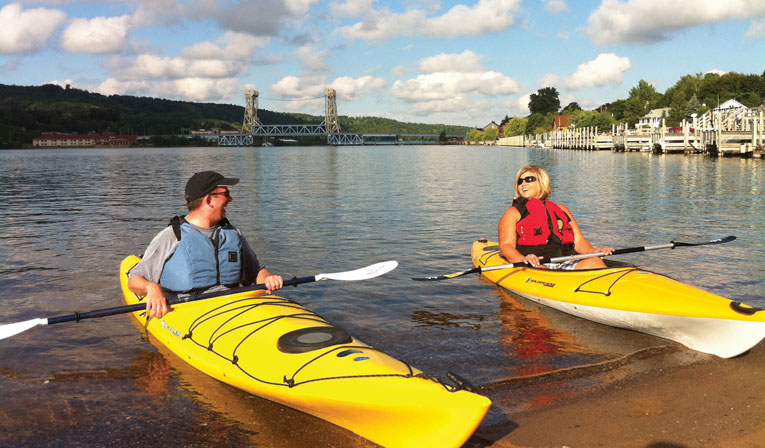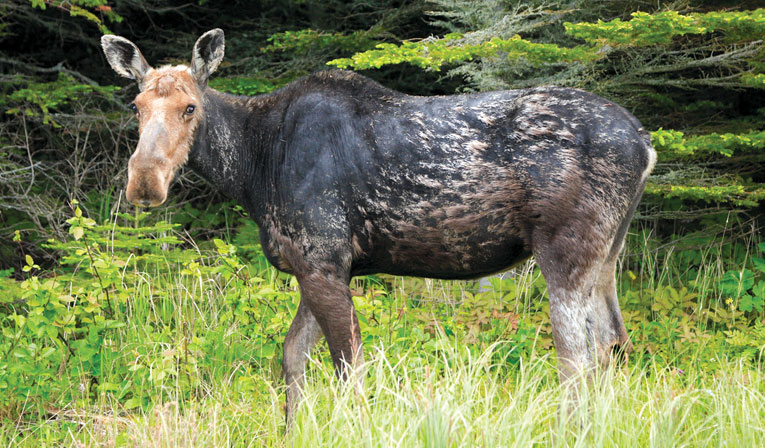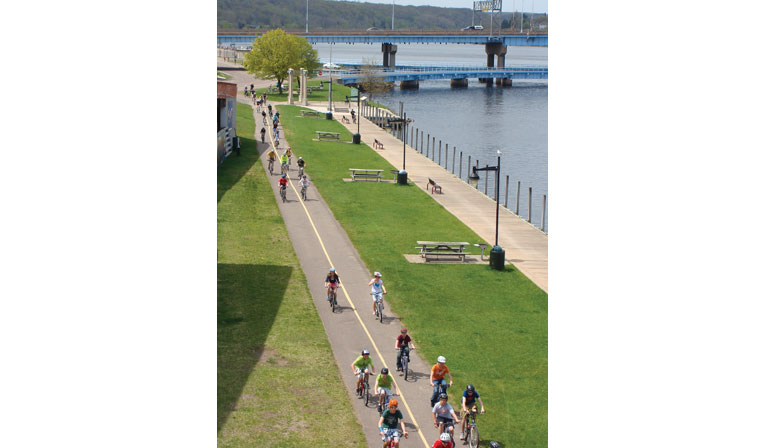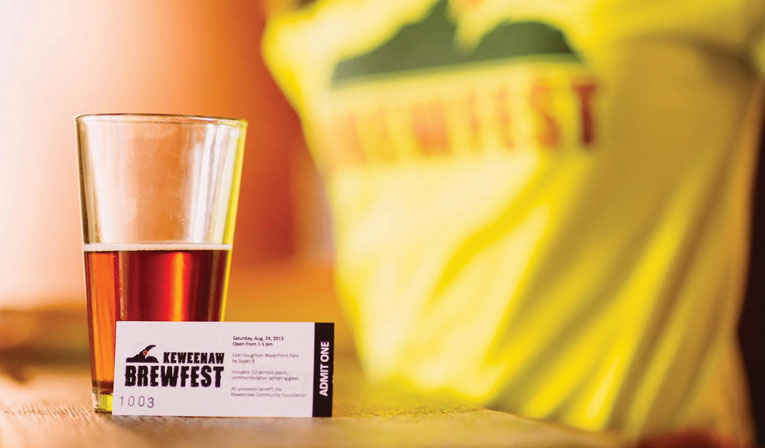Photo by David Clark
The beauty of Houghton, its sister city Hancock, and the rest of Michigan’s northernmost peninsula, is instantly obvious to anyone who motors, sails or paddles near shore. Settled on the Keweenaw Waterway, Houghton is the largest city in Copper Country and is a year-round getaway off Lake Superior.
Old-growth forests tower above rocky shelves, wide swaths of sugar sand beach dot shorelines accented by boulders and colorful agates, eagles soar from cliffs, and sheltered harbors invite visits to pristine wilderness areas, bordered by villages notable for multi-ethnic traditions dating back three or four generations.
But the key to the heart of this region — or so I’m learning from a tour guide at Keweenaw National Historical Park — is often invisible to the eye. It lies many stories beneath the rock formations, which only hint in color and sheen to the story far below.
Copper boom
“Does anyone have a penny?” ranger Dan Brown asks, prompting frantic digging through pockets to see who can find one first and hand it over. The coin may be relatively worthless for its buying power today, Brown notes, flipping it into the air for emphasis. But it’s of value here for the way it encapsulates the region’s history and claim to fame.
Horace Greeley saying, “Go west young man,” was uttering about the Keweenaw — a 75-mile long peninsula of rock shelves and ravines that was home to a mineral rush for copper, pre-dating the country’s more famous gold rush. Greeley was a stockholder and agent for the Delaware Mine, spending time in Michigan’s frontier in the summers of 1847 and 1848. Native Americans had, centuries prior, used copper to fashion primitive tools and clothing adornments. But it was Douglas Houghton — Michigan’s first geologist and namesake of the peninsula’s gateway city — who first noted the massive potential of the copper. He noted that copper is here, but “it’s going to be really hard to get.”
At the height of the boom, half of the nation’s copper came from this stretch — a story told through a loose collection of buildings that make up this unusual national park. Among the stops is Houghton’s Carnegie Museum — with its rotating exhibits on science, local culture and history — the Quincy Smelter (a collection of restored ruins on Portage Lake across from the city’s waterfront), and a daily tour of the town of Calumet a few miles north.
Hustle and bustle
Here, on a deserted street (outside of our small group of camera-toting tourists), we have to draw imagination to conjure the days when tens of thousands of people stood in our spots. We imagined them catching street cars, during a time when 35 languages were spoken on the streets and when a department store, once housed in the Vertin Building (now a gallery for local artists, with the words “Ladies Suits” still visible on the side), was the trendiest store north of Chicago, selling everything a “miner or millionaire” family might need.
During the peak of the copper boom, Houghton County had more millionaires per capita than any other county in the U.S. But that mining life, for those who did the real work, meant hard toil and danger, movingly depicted in tours of local churches and mines. At Calumet’s stunning St. Paul the Apostle, intricate stained glass windows feature saints known to intervene for workers in danger. And the most visceral way of understanding why thousands likely prayed before St. Joseph (patron of manual laborers) or St. Barbara (patron saint of miners) is by donning a yellow loaner hardhat and oversized Carharrt, and heading underground via the Quincy Mine Tour in Houghton’s twin city, Hancock.

Photo by Brian Rendel
Island Wildlife Paradise
 Isle Royale — a 6 hour ferry ride on the Ranger III from Houghton — is one of the country’s few national parks on an island, and its remoteness makes it one of the quietest (as determined in a national park study) and also one of the least visited. Those who visit the scenic wilderness area of 132,000 acres — noted for rocky cliffs and bays — can camp or stay in the Rock Harbor Lodge, and explore by land or water. A national park since 1940, Isle Royale is partly known as the base for the country’s longest-running predator/prey study; in this case, of the island’s interdependent wolf and moose populations. Visitors can even sign up for a learning vacation tour that lets them participate in the research. The park user fee is $4 a day (plus ferry costs). It’s closed during the winter.
Isle Royale — a 6 hour ferry ride on the Ranger III from Houghton — is one of the country’s few national parks on an island, and its remoteness makes it one of the quietest (as determined in a national park study) and also one of the least visited. Those who visit the scenic wilderness area of 132,000 acres — noted for rocky cliffs and bays — can camp or stay in the Rock Harbor Lodge, and explore by land or water. A national park since 1940, Isle Royale is partly known as the base for the country’s longest-running predator/prey study; in this case, of the island’s interdependent wolf and moose populations. Visitors can even sign up for a learning vacation tour that lets them participate in the research. The park user fee is $4 a day (plus ferry costs). It’s closed during the winter.
Another way to get to Isle Royale is aboard the Isle Royale Queen IV out of Copper Harbor — an hour drive from Houghton — which is a little over a three hour ferry ride. In addition to ferry service to Isle Royale, they also offer sunset cruises during the season. This line has been owned and operated by the Kilpela family since 1971.
A trip to Copper Harbor — hidden at the top of the Keweenaw Peninsula, against the backdrop of lakes, mountains and pristine forests — is off the beaten path, but well worth the trip.
Explore and enjoy the unique shops and galleries, amazing scenery, fine cuisine and friendly people. And if you are lucky, the northern lights (Aurora Borealis) will put on a show. There’s a certain magic here, and once you spend some time, you will feel the need to return.
Photo by Ray Dumas
Photo by DebMomOf3
“Focal point of the Finns”
In the town of Hancock, just across the canal from Houghton, street signs are written in both English and Finnish; one clue to the fact that there are more people of Finnish descent in this, and the surrounding three counties, than anywhere outside of Finland. Most homes and hotels have saunas, cafes serving pasties and pastries boast names like Kaleva (for a famed Finnish legend), and until it recently closed, the local flower shop was called Kukkakauppa, says David Maki, assistant editor of the Hancock-based, The Finnish American Reporter. The name, when translated, is “flower shop.”
Finnish workers, Maki says, joined miners from Cornwall, Italy, and elsewhere, in mines like Quincy, where a chill seeps in as our tram chugs through the door to the Number 5 shaft, and the temperature instantly drops by 30 degrees. Guides switch off the lights and instruct the group to touch the wall while imagining themselves as a miner, working alone, whose candle has just been accidentally extinguished. Between 1848 and 1901, there were no electric lights, and if a helmet candle went out, we’re told, feeling your way back to the shaft opening was the only option.
Gateway to fun
For more upbeat and artistic options for exploring the region’s historic, mineral and ethnic culture, a favorite is the impressive A.E. Seaman Mineral Museum at the Michigan Technological University, where 4,000 types of rocks and gems are on display at any given time. Within — what the director Ted Bornhorst calls the world’s finest collection of crystallized copper — are those highlighted for their whimsical beauty. Bornhorst says he especially likes one called the “grasshopper” for its shape (it looks like one), another referred to as the “buffalo” (same reason) and the “rocket,” so perfect its been used as a poster centerpiece.
Outside magazine recently named Houghton one of the best places to live in the United States for its adventurous options, bike lanes and green space, and National Geographic Adventure dubbed it a top 10 gateway town for summer sports. Local outfitters like to say there’s no outdoor fun you can’t have in a city and peninsula notable for mountain biking challenges, wilderness paddling and winter sports, like expert ski hills and ice climbing to the tops of frozen waterfalls up to 80 feet high.
Adrenaline junkies aren’t the only visitors who love exploring, though. Long stretches of sandy beach are often dotted with colorful Lake Superior agates. The chance to dig through poor rock piles (remnants from mining days) draws metal detector-toting treasure hunters during Houghton’s annual mineral week, held the first week of August.
The hunt for the thimbleberry is fun, too; though don’t bother asking a local to share hunting ground secrets. Find yours in jams or pies at roadside markets, or stores like the Jampot — an Eagle Harbor shop run by Eastern Orthodox monks to support their ministry. If you’re lucky, Father Basil will hand over your thimbleberry jam, hand-made truffles or brandy-soaked lemon pound cake after sharing a story about how they came for purgatory and found paradise, or a tale about the elf-like scoofies they like to say live in the waterfall next door.

Photo Courtesy of Keweenaw Convention & Visitors Bureau
Taste of the town
These days, copper is best found in gift shops, like Houghton’s Chickadee’s, as tiny nuggets on pretty necklaces. And remnants of mining days are tastily served up as memories via microbrews — with names like “Red Jacket Amber” or “Pick Axe Blonde” — alongside sacks of roasted peanuts in the cozy Keweenaw Brewing Company. For a full meal, The Library Restaurant and Brewpub serves dinners paired with brews like “Shafthouse Stout” or “Whiteout Wheat.” The menu at the Ambassador is particularly fun, says Houghton Chamber’s Trina Barrette; the Cudighi sandwich, popularized by Italian immigrants, is a local favorite. And for a Finnish and Cornish staple — the pasty meat pie that workers often carried into the mines — head to Roy’s Pasties and Bakery. Another must-stop is Peterson’s Fish Market on Quincy Hill. This three generation, family-run business operates two commercial fishing tugs year-round. Lake Superior fish are some the finest tasting freshwater fish in the world, and Peterson’s ship their fresh and smoked fish throughout the U.S. year-round.
Beauty in all seasons
Come summer, the Houghton County Marina along the Portage Canal makes a great exploration base. Bring or rent a bike, and take a ride on the 4.5-mile Waterfront Trail, which connects to more trails in the pretty Nara Nature Park and on the campus of Michigan Technological University (founded in 1885 to train mining engineers).
The waterfront also is port for the Ranger III, which offers both sightseeing tours and transportation to Isle Royale — one of the nation’s least visited, wildest National Parks. Moose and loons are a common sight, and those who want to explore via a guided paddling trip can book a tour through Keweenaw Adventure Company in Copper Harbor at the peninsula’s tip.
Autumn brings the energy of students returning to campus, as well as some of the country’s most brilliant fall color vistas. Brockway Mountain Drive, near the peninsula’s tip, boasts the highest drive above sea level between the Rockies and Alleghenies; and both local ski resorts — Mount Ripley in Hancock and Mount Bohemia in Lac La Belle — offer color tour ski lift rides to mountain valley panoramas.
For an unforgettable getaway, spend a night or two at Sand Hills Lighthouse Inn in Ahmeek. This former active lighthouse (the largest on the Great Lakes) was built on the shores of Lake Superior in 1917. The property was extensively renovated by the owners and converted into a bed and breakfast, which opened in 1995. Guests are treated to a guided tour to the top of the lighthouse for a magnificant view 101 feet above Lake Superior.
Another great place to stay in downtown Houghton, no matter the season, is Magnuson Hotel’s Franklin Square Inn. This premier property is the only full-service hotel serving the city and offers panoramic views from waterside rooms, and convenient access to recreational and snowmobile trails.
Winter Wonderland
But Houghton is a winter city — and by official designation; professional hockey was born here. Every summer and fall, the Copper Country Historic Fair in the historic Dee Stadium tells the story of how Houghton became the sport’s founding location. You can join a pick-up game at any of the rinks, but broomball — part soccer, part hockey and played with a broom — is so hot that webcams around the campus let parents watch students’ games online.
When 280 inches of snow falls during a typical Houghton winter, you have to embrace it, says Scott MacInnes, a longtime city manager and member of the worldwide Winter Cities Institute, of which Houghton is an active participant. Steep downtown hills host snowboarding competitions, the college runs a winter driving school, and the university’s annual Winter Carnival has become so popular that hotel rooms sell out months in advance. Intricate snow sculptures are the highlight, but the city’s also used that event to set world records at various times for the largest snowball, biggest snowball fight and most snow angels.
To find both snow and culture, Heikinpaiva — Hancock’s festival held at winter’s midpoint (January 23-26), or in folklore terms “when the (hibernating) bear rolls over” — is hard to beat. Locals dress in costume of characters from Finnish legends, including the mythical snow God responsible for all that snow. Kids play on kicksleds, and the highlight is a “wife carrying contest,” like one created in Finland.
“It’s just one of the many ways people choose to embrace winter rather than hide from it,” says Finnish expert Maki. “In a cliché way, it can be applied to the Finnish word ‘sisu,’ which, in a couple of sentences, is the willingness to persevere despite impossible odds. Winters aren’t always unbearable, but when they are, we make the best of it.”
Festival Highlights
 Bridgefest (June) celebrates the anniversary of the Portage Lake Lift Bridge — the key link to neighboring Hancock and the rest of the Keweenaw Peninsula. But the real draw is twin festival Bridgefeast — a celebration of all things seafood. www.Bridgefestfun.com
Bridgefest (June) celebrates the anniversary of the Portage Lake Lift Bridge — the key link to neighboring Hancock and the rest of the Keweenaw Peninsula. But the real draw is twin festival Bridgefeast — a celebration of all things seafood. www.Bridgefestfun.com
The Keweenaw Brewfest on the Houghton waterfront (late August) celebrates the area’s growing microbrew culture, with more than 40 breweries and 100 kinds of beers represented. www.K-c-f.org/events
Heikinpaiva (January 23-26) is Hancock’s mid-winter Finnish-American festival. “Heikinpaiva” translates to “when the bear rolls over,” signifying winter’s midpoint. www.pasty.com/heikki
Winter Carnival (February 3-6) has kept a sense of fun and humor since its founding in 1922, bringing snow sculptures, broomball, comedy skits, sleigh rides and a queen coronation to the festivities, organized by the Blue Key National Honor Society on the Michigan Technological University campus. www.Mtu.edu/carnival
The CopperDog 150 (February 26-28) is a spectator favorite, with multiple teams of 10 dogs racing 150 miles over three days. www.copperdog150.com
Photo Courtesy of Keweenaw Brewfest


